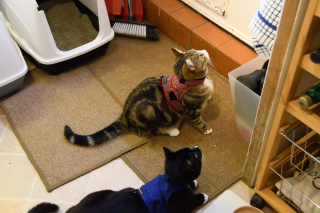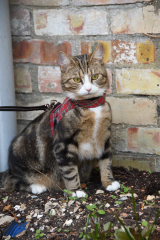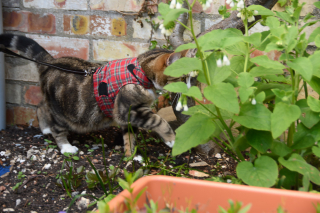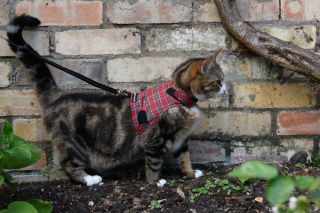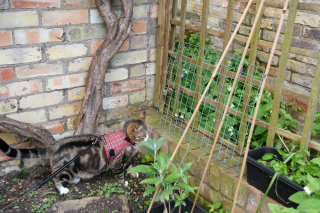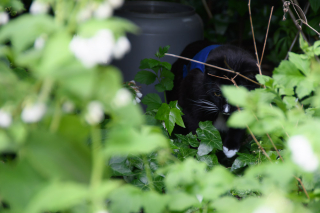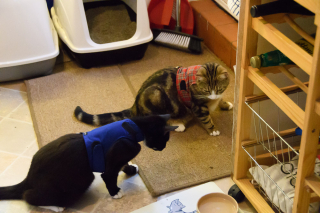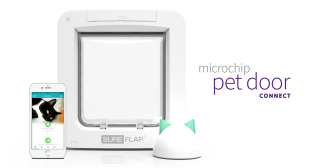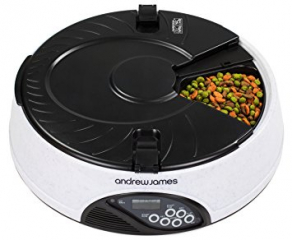Because of our exceedingly close proximity to probably the busiest road in town coupled with my fears of letting them loose, the cats spent their first 14 weeks here as house cats. One of their favourite places has been the cat tree in the office bay window, both for watching the world go by but also for snoozing in the sun. However, since I had the high hedge between the kitchen and the rest of the garden chopped down, they’ve spent a lot of time on the kitchen windowsill, surveying the garden and chattering at the birds, like this on youtube.
I knew it was not fair to keep them cooped up and so, after yet more hours studying articles and Amazon reviews I ordered two Mynwood jacket harnesses and two retractable leads and awaited their arrival with some trepidation.
Tux has a bright blue jacket with a blue lead and Tabs has a smart red Royal Stuart tartan one with a red lead. The leads are 8 metres long, so the cats are able to explore for a decent distance but the leads can be instantly retracted or stopped if required.
Initially they weren’t so keen on having the jackets strapped on but a few treats persuaded them that it was worth it. We attached the leads and ventured in to the garden. After a few visits outside, they began to wait by the door, looking up at the door handle in expectation of the door being opened.
On his first outing Tux confidently strode out into the middle of the garden and looked around with interest, investigating this and that.
And, much to David’s horror, that included bumble bees. Well, let’s face it, Tux is intently interested in everything! But Tux and the bees in combination gave David the hebejebes. Not only have we seen Tux carrying one in his mouth (which I’ve read about cats doing) but I’ve actually seen him eat them.
However, on that first outing, Tabs sidled along the wall and then under the garden bench against the back wall whilst sniffing the air in this new place but soon she began to investigate it.
From being apprehensive at the beginning, by the end of three weeks Tabs was quite confident, taking great interest in the world around her.
Click on each image in turn to view in full size
We gradually accustomed them to the big wide world and the cats clearly enjoyed being out there. They could get through our back gate into a narrow passage way which leads to the side road which is, unfortunately, almost as busy as the main road.
Quite quickly, Tux went to sit by the wrought iron gate at the end (which already had chicken wire across the base so they couldn’t get through) and watch what was happening. But Tabs took several outings before she ventured past the halfway point, preferring to sit and watch from there.
Sometimes they got spooked, by a large dog passing or noisy traffic from the main road, and ran like mad for home. I learnt quite quickly not have inadvertently wrapped the lead around my fingers. However, being spooked didn’t stop them wanting to go out again.
At the other end of the passageway there is another wrought iron gate which evidently hasn’t been opened in years, hidden by a lot of foliage from an overgrown elderflower shrub, ivy and other plants. Both cats took to exploring this area and so I had to crawl into it to make sure there was no way for them to get through the gate into the garden into which the gate led. I know that two dogs live in that house/garden.
I know Tux loves hiding in dark places but I didn’t like not being able to see what they were up to so I eventually cut back quite a bit of the foliage.
It was clear that Tux was interested in what lay beyond the other gate, the one to the street. Whilst he couldn’t get through the gate, he was eyeing a fence post at the side; it was well within his ability to jump to the top of it and down the other side.
So David took Tux for a walk on his lead along the side road and out to the main road, acquainting him with the neighbourhood, making sure that Tux knew the way home. Unfortunately, he couldn’t do this and take photographs at the same time.
Very soon Tux took to scrabbling at the door and making noises at me so that I’d abandon the washing up and take him out. The cats began to recognise the sound of the key turning in the lock and come running. It was clear that they needed to be able to come and go as they wanted so it was David’s time to study the Amazon reviews and to choose a cat door.
We wanted one which keeps strays out and only lets Tux and Tabs enter the house, recognising them by their microchips. And one with a curfew programme. I may have, somewhat reluctantly, been persuaded that they need to be able to come and go as they want but I do want to know that they are safe in the house over night.
Whilst we were waiting for a handyman to come and enlarge the opening of the existing (but boarded up) cat flap in the back door and to fix the new cat door in place, David tried to get the cats familiar with the door. He fixed it into a box and began trying to get them to go through with the promise of a treat on the other side. After some initial success with Tux, and lack of interest from Tabs, he had to give up because Tux worked out that there was no point to going through the flap as he could just walk around the box to get the treat.
When Paul, the handyman, arrived he and I shut the cats out of the sitting room so they couldn’t get at the kitchen and the open door. Now, for Tux, a closed door presents a challenge. No matter whether he is shut in or shut out, he wants to be on the other side of that door. Couple that with all sorts of interesting noises coming from the other room and he was beside himself. I spent ages playing with him in an attempt to take his mind off it all.
After Paul had gone, I let the cats into the room and they immediately went to investigate this new thing in the door, through which they could see bright day light. Tabs soon lost interest and went off but Tux went crazy. He was scrabbling at it, wanting to go out.
I was sat on a footstool whilst poop scooping the litter trays and watching him as he became more and more agitated. I wasn’t concerned as I knew David had programmed the door to be locked and that it wouldn’t open.
Well, that lack of concern was silly, wasn’t it? Tux got it open!
Because I was so close, I managed to grab him as his head and shoulders disappeared through the door and haul him back again, kicking and protesting loudly (him not me but I felt like doing it too). I banned him from the sitting room once more and Skyped David at work.
Being somewhat of a geek (well, it is required for his job) David had chosen a door with an app for his phone. He was able to lock it again remotely so, in theory, it couldn’t be opened from inside or out. And I barricaded the door on the inside so Tux couldn’t get near it, though he tried his hardest.
After I collected David from the station, we took the barricade away from the cat door and Tux demonstrated his determination to get out. David videoed his attempt and was quite shocked that Tux succeeded (see below).
Although I’d already had proof that he could do it, because neither of us were within reach to grab him, Tux exited very quickly but David was able to bring him back before he disappeared over the horizon.
My memories of that evening are somewhat blurred but I’m aware that I was close to hysteria.
There have been terrible stories of cats around the country being taken at night and mutilated by human predators and I want to keep those cats safe.
What was the point of spending so much money on a door which could set a curfew if Tux was going to be able to get it open?
Because David has so much experience of cats, it is hard for him to understand the fears which my lack of experience leads me to imagine. My mother always did say I had an over active imagination and, right then, it was running riot and wasn’t helped by childhood memories of a neighbour’s black kitten being run over when we lived on a very busy road in south London.
David taped cardboard to the outside of the door so that no light would show through and that seemed to settle Tux somewhat.
By the time I got up the next morning David had already researched the problem on the internet, found a few others who’d had the same experience and was on the phone to the manufacturer.
They were aware of the problem and had a solution ready, which they would send us. Not yet fixed to the door as standard, it is is free to those who have cats like Tux, intelligent cats who work out how to open the locked door.
It is a truth universally acknowledged, that every new parent thinks their new offspring is the cutest, prettiest, handsomest, smartest child who ever was born. As somebody who has never had children, perhaps it is not my place to comment, other than to say that it is evident that some of those parents are sadly under a misapprehension.
However, as a novice cat owner with four months experience I can confidently say that Tabs is the cutest and Tux the smartest cat, not just in his looks but in his intelligence.
Now, you may think that this is a fond cat slave’s misapprehension about her owner’s intelligence but the cat door manufacturer has confirmed Tux’s intelligence.
Some people have smart phones. We have a smart cat.
David writes about this period:
These kittens were about 8 months old when we got them and they were now coming up to 12 months, which means we’ve had them for about a third of their lives. Unsurprisingly, they’ve grown, both physically and otherwise, and their habits and needs have changed. For one thing, they no longer comfortably fit on the cat tree platforms and are constantly at risk of falling off.
Increasingly, it became apparent to me that they needed the freedom to come and go outside at will lest they go stir crazy. Susan was not keen on the idea given the two fairly busy roads nearby and the stories you sometimes hear about people doing dreadful things to cats at night, but also could see the behavioural changes and inexorable need for a cat door.
While I researched options and selected a suitable model, we set about training them about the Big Outdoors. Susan found a kind of partial jacket thing that velcroes around the neck and chest without impeding the forelegs and to which a leash could be attached. I was initially not keen on the idea, at least, not as a long term thing, but could see the sense in them as the valuable training aid they proved to be.
We didn’t want to let them out first time they were put on so we tried to acclimatise them to the jackets before they went out for the first time. One change at a time. Needless to say, they hated those wretched things — until, that is, with leash attached we opened the back door for the first time. Thereafter, they associated the jackets with Going Out, which they loved.
And, while they didn’t exactly fetch the jackets like a dog, they would sit by the door and even miaow loudly leaving no doubt as to what they wanted and, if the jackets were the price of Going Out, it seemed a price they were willing to pay. They would accept these undignified jackets being fitted with as much grace as is possible for a cat.
The first time they were allowed out on a leash, they were understandably hesitant and cautious, but they pretty quickly got used to the idea and explored every nook and cranny of our garden (and made several bids for our neighbours’ gardens as well).
Inside a week, they were confident about their territory and enjoyed keeping up with the news in the Daily Olfactory. Unfortunately, we have few photos from this period, because keeping two cats on leashes under control and without getting tangled leaves little time for any decent photography, and they can move so damned quickly when they want to.
Susan says: Only once did I try taking both cats out on the leads at the same time. It was exhausting and quite shredded my nerves, so thereafter the cats had to wait until David came home before they could go out together.
Tux quickly developed an unfortunate fascination with bees and although he sometimes caught and occasionally ate them, he never seemed to get stung. I didn’t much like this and would discourage it to some degree (especially over the May Bank Holiday), but I also knew that, once allowed out on their own recognisance, nothing we could do could stop him from chasing bees and if he were going to get stung and have a reaction to it, it would be better if it were to happen under my supervision and when I could get rapid medical attention should it be needed than if it were to happen when nobody was about. Still, it turned into nothing, despite bee-catching.
I selected this cat door not, of course, because it is Internet-connected but rather because it has the facility to impose a curfew. They can get in at any time, but the outward direction locks and unlocks automatically at the appointed times. The inward direction is also selective and is unlocked by their implanted RFID chips.
Actually, the Internet connectivity turns out to be less a gimmick and more practically useful than you might think: first, it means we have a pretty good idea of whether they’re in or out (it can identify which cat by their chip) and, just as importantly, when they went in or out.
There was an old cat door which had been blocked off some years before we moved here and so, of course, it admitted no light. After the new cat door was installed, suddenly they could see out and Tux knew he could get through even, as it turned out, when it was supposed to be locked outward. By dint of scrabbling at the door and hooking his claw between the flap and frame, he could depress the latches that keep the door locked and pull it inwards.
So we blocked up the door from the outside to prevent light from tempting him while we figured out what to do.
It turns out that a small number of other people have had similar problems, and they said that Sure’s customer services sent them some replacement parts that would address the problem. So I called them up, and we were duly sent (at their expense) a replacement flap that had some mouldings (probably fabricated by a “3D printer”) attached over where the latches catch the flap to prevent paws from interfering with them, and also a replacement latch unit with modified external latches. Truly first class service.
The product is fairly new to the company’s line-up and has already gone through a few iterations. Newer production runs will probably incorporate at least the new latch mechanism but not until current inventory is exhausted. The modification of the flap is a bit more involved, and whether that will make it into future iterations depends on the cost-effectiveness of modification of the plastic tooling (metal moulds used to manufacture shaped plastic and which are therefore customised and expensive to alter). If it’s rare problem, they may not bother.
The system keeps a 7-day history of their pattern of movements (which allows us to spot unusual behaviour which might signal something is wrong), and some aspects of that surprised me. Tux spends more time out than Tabs (no surprise), but Tabs goes in and out rather more frequently. To pick one day at random — the day of the Royal Wedding, the first reasonably warm day since our records began — Tux was out for nearly nine hours (of the 16 non-curfew hours) over 16 round-trips, where Tabs was out only five and a half hours over 36 round-trips! Sometimes she’ll come in and then go out again almost immediately, as if to check that everything is still there, and both get increasingly active toward dinner time (though what they think going in and out will accomplish, only a cat could say).
Their distinctive personalities manifest in so many different ways, including what they do when outside. Tabs is more watchful and contemplative, and has shown no interest in going beyond our garden, the neighbour’s garden and the passageway. Tux, on the other hand, is most definitely the adventurer — a characteristic that got him into trouble several times when first allowed out off the leash.
Susan says: Last week I bought a new mobile phone and had to go into a phone shop to have the SIM card from the old phone cut down to nano size for the new phone. Just after the chap had inserted the card in the new phone a sound was heard, not one you’d expect to hear inside a shopping mall.
“Did you just hear a cat miaow?” I asked him. “Well, I thought I did” he replied with a puzzled face. I laughed and said “that means one of my cats has just entered or left the house” and showed him the app.
Fortunately, given the number of times the cats go in and out, once the novelty factor has worn off the miaow alert can be turned off. Now I simply have the Sure Petcare screen open on my computer screen and can see whether the cats are in or out.
Susan continues:
Whilst we were dealing with the cats’ impatience to be outside — training them with the harnesses and leads, researching the cat doors and having the chosen one installed — a new problem was arising.
As I’ve said before, Tux considers any closed door a personal affront and he will agitate to have it opened. The sound he made scrabbling at the door disturbed David whilst he was sleeping, which isn’t so good when you have to go to work in the morning. And so we soon learnt not to close our bedroom door at night.
Initially Tux was coming in around 7am. We didn’t know if this was because he was in search of company or if he wanted to be fed. His way of announcing his presence was to jump on the bed and walk all over us. Whilst David could slept through this, I couldn’t. (Thoughts of Simon’s cat come to mind… and yes, I have checked that there’s no baseball bat under the bed!)
I developed the habit of going down to the kitchen, with the cats overtaking me on the stairs and racing into the kitchen, leaving no doubt as to the fact they wanted their breakfast.
I confess that one morning I took just one step towards the stairs, to engage their attention and then stopped, whilst they raced down, swerved around the corner, through the sitting room and into kitchen. Once there, they evidently discovered that I wasn’t with them and so, as I waited at the top of the stairs, two little faces appeared around the corner at the bottom, looking up at me enquiringly. “What are you waiting for? We’re hungry.”
As the mornings grew lighter, so Tux began arriving on our bed earlier and earlier, 6am, sometimes 5am.
I suffer from sleep apnea and tinnitus, both of which cause me sleep deprivation. I also have delayed sleep syndrome (for which I am prescribed melatonin) and so having my rare good sleep disturbed by Tux was causing me to feel ill.
David’s work was suffering from his interrupted sleep and I was getting up earlier and earlier, from 7am to 6.30 to 6am and even earlier, to remove Tux and let David sleep. Sometimes I fed them and then went back to bed, leaving a note for David to let him know what I’d done, in case the cats tried to tell him that the nasty woman upstairs hadn’t given them any food. But I couldn’t always get back to sleep.
And so, early one morning, I found myself checking out the internet again and found many other people who had experienced the same problem. It was generally held to be a feeding problem, with too big a gap between the evening meal and the morning meal. Automatic feeders seemed to be the answer.
Originally Tux and Tabs were having a dry meal in the morning, at about 8am, a treat stick at around 1pm for lunch and a wet meal in the evening, around 7.45 to 8pm. Perhaps the nearly 12 hour gap between evening meal and morning meal was too long.
Once more, I began reading articles and reviews on the internet, this time about automatic feeders. I had to identify what we wanted/needed and then find the right model. We’re only concerned with the dry food in the morning and don’t need one with an ice compartment to keep wet food fresh during the day.
I progressively narrowed the list until I chose the Andrew James Automatic Cat and Dog Bowl. Each unit has six compartments and can be programmed over one to six days, feeding one portion a day or more as required over fewer days. The compartments are small, making it harder for one cat to muscle in on the other’s food. My only concern about the feeders is that the bowls are black and in a small amount of light, it’s hard to see the plain darkish dry food in them (rather than the coloured food as per the illustration) though the cats may be able to see it better than I can.
We held a trial run in the office, which David videoed. The cats could probably smell the food and checked the feeders out when they were closed but lost interest as they couldn’t get at it. Once the doors slid open and they realised there was food to be had, it was a different story. As per usual, Tabs ate hers and then showed interest in Tux’s portion.
With a feeder for each cat, we decided to provide their morning meal in two amounts, half at 4am, half at 7am. So each feeder requires refilling and restarting every three days. The feeders proved to be a brilliant solution.
But…. it didn’t last long.
Tux was still coming in early in the morning, but he mostly just purred at us loudly and so long as he was acknowledged, however sleepily, he’d settle down for a while with us.
However, he was becoming very interested in the air which is expelled from my sleep apnea mask in small holes in the mask holder over the top of my nose, and would get very close to the mask. And once, whilst moving around, he managed to dislodge the air hose from the mask. It’s impossible for me to sleep through such happenings.
A few days ago I happened to wake just before 4am. Both cats were lying on the floor by the side of the bed, evidently waiting for the feeders to open in their room. I thought I’d listen for the click and watch them but they heard the click and zoomed off before I could even blink. By the time I heard David’s recorded voice calling ‘puss, puss, puss’ they were halfway through the food.
Although David has set the webcam to record the cats, about fifteen minutes before and after each programmed feed, unless we’re physically there, we can’t see how much they eat before they go off though we know that they don’t always eat it all immediately. Nor can we see whether both cats come back to finish the feed or whether only one is doing so, thus depriving the other. So I watched them to see how much of it they were eating and to see that they each got their own share, at least at the start of the feed.
Of course, by this time I was fully awake and went down to the kitchen to make myself a hot drink and get something to eat before going back to bed.
Tux followed me down. He wanted activity. He wanted to be outside. He scrabbled at the cat door but the curfew was set from 9pm to 5am.
We decided to keep the feeding times the same but to change the curfew so that the door unlocks at 4.05 am, straight after they’ve fed. Hopefully, they’ll then be able to go out and expend their energy without disturbing us in the mornings.
Luckily, after being up for two hours, I was able to go back to sleep at 6am and sleep through until nearly 11am, as David was at home for three days, working on his PhD dissertation.
The dawn chorus from the birds in the nearby trees is an exceedingly raucous sound. It wakes me and I’m pretty sure that it and the lighter mornings have been waking the cats, making Tux in particular very restive. I can mitigate matters a bit by hanging a blackout curtain liner and ensuring that the window is closed to reduce some of the noise, though if it is hot weather the window needs to be open at night.
David wants to write a programme which adjusts the curfew period to take account of the progressively lighter mornings and then the darker mornings as the year progresses.
Three days ago Tux came in and woke me up, so I decided to get up, check the feeder had operated correctly and then bring them downstairs to show them that the cat door was opening earlier than before. However, when I checked the screen, I could see that both cats had already discovered that for themselves and had already been in and out. So I ended up feeling guilty that I’d deprived Tux of company when he came to visit us.
The next day I awoke early, not woken by Tux but by myself! Evidently my system is now tuned to waking around 4am and I need to persuade my body to change this unwanted habit. But it was an improvement in that Tux didn’t come in early, though he did appear later.
Yesterday, for the second day running, there was no early morning visit by Tux. The system reports that he left the house at 4.18 closely followed by Tabs.
Tux:
left at 4.18, re-entered at 5.03,
left at 5.51, re-entered at 5.59,
left at 6.04, re-entered at 6.14,
left at 6.24, re-entered at 6.46,
left at 7.02, re-entered at 7.30,
left at 7.35, re-entered at 7.49,
left at 7.53, re-entered at 8.21,
left at 8.35, re-entered at 8.39,
left at 9.15, re-entered at 10.20
Tabs:
left at 4.18, re-entered at 5.12,
left at 5.50, re-entered at 6.03,
left at 6.04, re-entered at 6.14,
left at 6.27, re-entered at 6.34,
left at 6.38, re-entered at 6.44,
left at 6.53, re-entered at 6.56,
left at 7.00, looked through the door at 7.02, re-entered at 7.09,
left at 7.14, re-entered at 7.22,
left at 7.36, re-entered at 7.47
left at 9.14, looked through the door at 9.23, re-entered at 9.23.
I was in the kitchen then and watched as she tried to get a thin twig through the cat door, eventually dropping it outside though she has previously managed to get a twig inside (which she plays with).
left at 9.24, re-entered at 9.36
left at 9.36, re-entered at 9.40
left at 9.41, re-entered at 9.45
left at 9.47, looked through the door at 9.51, re-entered at 9.52
left at 9.53, looked through the door at 9.55, re-entered at 9.55,
left at 9.56, re-entered at 10.06.
Between 4.18 am and 10.20 am, Tux made nine trips outside but Tabs made sixteen. However, Tux was outside for longer periods.
Evidently, after such comings and goings and undoubted adventures chasing bees and stalking insects, and, in the case of Tux, checking out his territory, they need to recover their energy and, at 11.46 as I was writing this account, both Tux and Tabs were snoozing in the cat room, Tux on the fluffy blanket on the floor (which they often use as a bed) and Tabs on the highest point of the shelves.
In the last week, Tux was outside for 6.3 hours, 8.9 hours, 7.7 hours, 6 hours, 4.9 hours and yesterday, 5.7 hours.
In contrast, over the same six days, Tabs was outside for 4 hours, 5.5 hours, 4.7 hours, 4.2 hours, 2.7 hours and yesterday, 4 hours.
The daily number of visits outside range from 8 to 19 for Tux but from 19 to 36 for Tabs. As can be seen above, she may be outside for fewer hours than Tux but her frequency of going out and coming back is much greater.
Being information gatherers, both David and I are fascinated by their reported comings and goings. I just wish I knew what makes Tabs come in and immediately turn around and go out again.
Unfortunately, Tux did come in this morning, after he had been outside, but not until much later compared with his earlier attempts at being a furry alarm clock. That may have something to do with the fact that it had rained over night and perhaps he wasn’t so happy at being outside, though both cats have been in and out several times this morning, coming home a bit damp.
Following Tux’s initial success in managing to open the locked door, the modification supplied by the manufacturers has worked extremely well and there have been no more unforeseen events, and thankfully, no breaking of the curfew.
I think David made a good choice of the cat door and it is clear that they are benefiting from the change, from being house cats to cats which have the freedom to come and go as they wish, curfew apart.
So the question now is: What are they getting up to with their new found freedom?
Next: Tux goes adventuring
